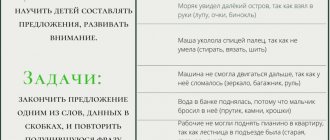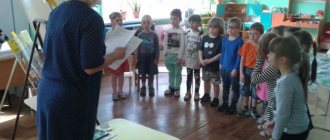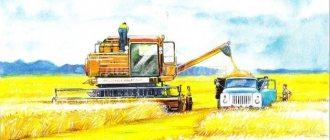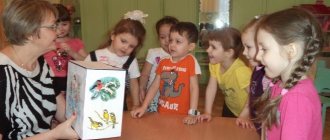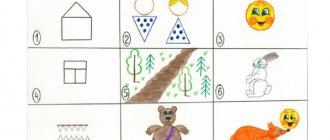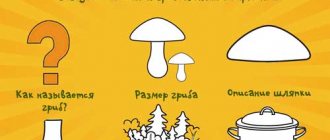Lesson on speech development “Retelling the fairy tale “The Hare is a Braggart”” for children 5-6 years old
Lesson notes
Retelling of the fairy tale “The Hare is a Braggart” and the saying “Our fairy tales begin.”
for children of a general developmental group, aged 5 to 6 years
Educational area
: Speech development
Class:
Speech development
Target:
consolidate children's knowledge about Russian folk tales
Tasks:
Educational
: Help children make a plan for retelling a fairy tale. Learn to retell a fairy tale, sticking to the plan. Introduce the saying “Our fairy tales begin.”
Educational:
Develop the ability to retell a text coherently, consistently and expressively.
Educational
: To develop the ability to understand a learning task and solve it.
Materials and equipment:
Demo material:
presentation, reader for children 5-6 years old
Progress of the lesson:
Introductory part
Motivational moment:
Educator
: Do you like fairy tales? (children's answers), why do you love them?
You know, children, what a disaster happened! The heroes of fairy tales got lost in a fairytale forest and cannot remember where they came from. But how can we help fairy-tale heroes? (children's answers) And how to get to the fairy forest? (children's answers) We need to close our eyes and say the magic words, but before we do this, let's stretch our tongue.
Articulation gymnastics
Tongue exercises:
If in a fairy tale
believe with all my heart
Doors will open to a magical world... (Open mouth slightly)
You can get there easily
On the magic carpet - airplane (keep your tongue wide on your lower lip)
On a flying big ship (raise the side edges and cup the tip of the tongue)
On a raft on a milk river (wide, relaxed tongue)
And riding on the Little Humpbacked Horse (click tongue)
You can fly into a fairy tale on the Firebird (the tongue moves up and down)
You can roll on a kolobok (circular movements with the tip of your tongue across your lips)
Or you can go on a train.
Breathing exercise
"Locomotive"
II. Main part
The teacher asks the children to name Russian folk tales known to them. Children remember and name fairy tales
Teacher: “They ask for fairy tales, but now you friends get to know us”
.
The teacher asks the children riddles about fairy tales.
1. Didn’t lie on the window, rolled along the path (kolobok)
2. There is neither a river nor a pond - where can I drink water? Very tasty water in the hoof hole! (sister Alyonushka and brother Ivanushka)
3. The mouse found a home for itself, the mouse was kind: in that house, in the end, there were many tenants (teremok)
4. The beautiful maiden is sad, she doesn’t like spring, it’s hard for her in the sun, the poor thing is shedding tears (Snow Maiden)
5. Oh, Petya, simplicity, you messed up a little: you didn’t listen to the cat, you looked out the window (the cockerel is a golden comb)
6. But the road is long, and the basket is not easy, I wish I could sit on a tree stump and eat a pie (Masha and the Bear)
7. The kids opened the door, and everyone disappeared somewhere (the wolf and the seven kids)
8. Walking briskly along the path, the buckets themselves drag water (at the command of the pike)
Next, the teacher asks how Russian folk tales usually begin (Once upon a time, once upon a time)
. He talks about how many Russian folk tales have a fairy-tale ending, for example: here is the end of the fairy tale for those who listened to the end.
Invites children to a physical education session.
Kolobok, Kolobok, They walk in a half-squat, with their hands on their belts.
Kolobok is a ruddy side.
They rolled along the path, running on their toes, holding their hands on their belts.
And he didn’t turn back. Standing face in a circle,
I met a bear, a wolf, a bunny, they depict a bear, a wolf, a hare.
He played the balalaika for everyone. Depict playing the balalaika
He sang on the fox's nose, They danced in a crouch
He is no longer in the forest. They shrug their shoulders.
After physical education, the teacher continues the conversation: Now listen to what words I’m about to say, little book, house, suitcase. What size objects are we talking about? Correct about very large objects. “The Hare is a Braggart” talked about himself.
:
“I don’t have a mustache, but whiskers, not paws, but paws, not teeth, but teeth
. The teacher repeats a quote from the fairy tale, and the children help him in unison, pronouncing nouns with the suffix -ish.
It must be in the fairy tale "The Braggart Hare"
We are talking about a giant hare. After listening to the children's answers, the teacher tells a fairy tale. Before telling the story, the teacher reads a saying:
Our tales begin, our tales are woven.
On the sea and ocean, on the island of Buyan, there is a birch tree with a cradle hanging on it
The bunny is fast asleep in the cradle. Grandma sits nearby and tells fairy tales to the bunny.
Old tales, not short, not long
About the cat. About the spoon, about the fox and about the bull
About the crooked rooster, about geese, about swans
About smart animals.
This is a saying, not a fairy tale, a fairy tale will come.
Telling the fairy tale “The Boasting Hare”
.
Once upon a time there lived a hare in the forest: in the summer it was good, but in the winter it was bad - he had to go to the peasants' threshing floor and steal oats.
He comes to one peasant at the threshing floor, and there is a herd of hares. So he began to brag about them:
- I don’t have a mustache, but whiskers, not paws, not teeth, but teeth - I’m not afraid of anyone.
The hares told Aunt Crow about this boast. Aunt Crow went to look for the boaster and found him under the kokorina tree. The hare got scared:
- Aunt Crow, I won’t brag anymore!
- How did you boast?
- And I don’t have a mustache, but a mustache, not paws, not teeth, but teeth.
So she patted him a little:
- Don't brag anymore!
Once a crow was sitting on the fence, the dogs picked it up and started crushing it, and the hare saw it.
“How can I help the crow?”
He jumped out onto the hill and sat down. The dogs saw the hare, threw the crow after him, and the crow again onto the fence. And the hare left the dogs.
A little later the crow met the hare again and said to him:
- Well done, not bragging, but brave!
Conversation on content.
- Who was the braggart in this tale? (hare)
- Where did the hare live? (In the woods)
- When did he have a good time and when did he have a bad time? (good in summer, bad in winter)
- Where did he go and why? (to steal oats from the threshing floor)
- Who was he showing off to? (in front of a herd of hares)
What did the hare say while boasting? (I don’t have a mustache, but whiskers, not paws, not teeth, but teeth - I’m not afraid of anyone)
- Who did the hares tell about the braggart? (to aunt crow)
- How did the crow shame the hare? (Don't brag anymore!)
- What happened to the crow? (a crow was sitting on the fence, the dogs picked it up and let’s crush it)
- How did the hare help her? (He jumped out onto the hill and sat down. The dogs saw the hare and threw the crow.)
- What did the crow say to the hare? (Well done, not a boaster, but a brave one!)
-Well done guys, you remember the fairy tale well. How can you evaluate the actions of a hare? (children evaluate the hare’s actions from a moral point of view)
.
Our journey into a fairy tale has ended. What was it called? (Bragging hare)
.
“And as you and I always say: “That’s the end of the fairy tale.” Well done who listened"
.
The teacher tells the Russian folk tale “The Braggart Hare”
in arr. O. Kapitsa.
“So what was the hare like in the fairy tale?”
,” the teacher sums up.
“Was he really a giant?”
. The teacher asks to characterize the hare (at first he was a braggart and a coward). Seeing the crow, he got scared, then showed himself to be a real brave man. The teacher praises the children for good answers.
III.Final part
Educator:
-Where were we today?
— Did everything work out for you or did you have difficulties?
How to instill in your child a love of reading
Parents often complain: their child does not like to read. Making a reader out of a child is a good goal, and we have collected advice from psychologists and writers on this topic.
Read more
Re-reading
Before re-reading, you need to set up a retelling: now read (we will read) again, and you try to remember and retell.
We read literary texts as a whole, but scientific ones can be divided into semantic parts (paragraphs) and retold in parts.
Actually a retelling
It is important not to peek, but to retell it completely yourself. Don't interrupt your child. Listen to him, teach him how to build a monologue. If the child does not know how to start, then ask him a leading question, but do not teach the first sentence. After the retelling, offer to look into the text to understand what he forgot or missed, help him.
Thus, the entire text is retold.
Types of retelling
Schoolchildren must master various types of retelling.
| Type of retelling | Peculiarities | Problems of development | How to help children |
| Detailed | Retelling educational or artistic material close to the text. | Not knowing where to start. Lack of emotional coloring. Non-use of text vocabulary and figurative expressions. Loss of details or individual events. | Don't memorize individual phrases. When analyzing a text, ask where the text begins? How else could you start? Pay attention to the means of expression in the text, ask them to repeat them. Use the schematization method. |
| Selective | Retelling part of the text to answer a question. | Inability to select the right passage, retelling the entire text. | Make a plan for the text, divide the text into semantic parts. |
| Compressed | A brief retelling of the essence and main events. | Inability to briefly convey the content of the text, leaving for a detailed retelling. | Learn to highlight the main ideas. Make a plan for the text. |
| Creative | Changing the text and including new characters, dialogues, your own ending, your own conclusions. | Inability to come up with a new character or ending, or draw your own conclusions. | Consider various options for action, suggest choosing heroes from other works. Learn to express your point of view using leading questions: -What would you change? — Would you like to live there and why? -What would you do if you found yourself in this place? |
We teach children to retell
To retell a text, you need to understand it. Understanding a text begins with its complete perception.
But before reading, you need to figure out the unclear words in the text. This is what the preliminary work is all about. It is necessary to write down new and complex words and sort them out with the children.
Remember: the text for retelling is always read twice.
Primary reading
The first time we read the text in its entirety to understand the general meaning. Any text is devoted to one topic or event, so it is important to read it from beginning to end. Make sure nothing distracts your child from reading. Adults read the text to preschoolers and first-graders. As soon as the primary reading technique becomes high enough, let the child read on his own. Younger schoolchildren read the text aloud, and then you can allow the child to read to himself.
After reading, ask your child a few questions to understand the integrity of what he read:
— What is the text (story, fairy tale) about? — What new (interesting) did you learn? - What happened (described)? —Who is the main character? — What do you remember most?
We break the text into meaningful parts - make a plan. Scientific texts have paragraphs, and children will have no trouble highlighting them. We name the parts and determine their content, reading selectively the beginning and end, briefly formulating the main ideas.
We move on to working on the images, remember how the author describes certain events, and read the characteristics from the text. We look at the illustrations, if any. We ask the child to express his opinion about what he read.
Next you need to take a short break.

